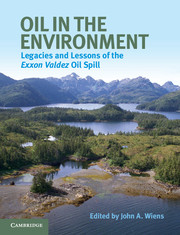Part I - Introduction and background
Published online by Cambridge University Press: 05 July 2013
Summary
Introduction
Every oil spill is different from the ones that preceded it. This is due in part to differences in the spill itself – the nature of the oil and the circumstances of the release – but it also stems from differences in the context of the spill – the setting, the resources at risk, and how people respond to the spill. All of these factors affect how science is brought to bear on investigating the spill and its consequences.
The two chapters in this section consider these factors in two ways. Chapter 1 (to which many of the authors contributed) introduces the environmental setting of the Exxon Valdez oil spill, what happened during the spill and to the oil that was released, the cleanup responses and the launch of scientific studies, and the regulatory and legal context of the spill responses and studies. Separate discussions consider: the characteristics of crude oil; the importance of assessing exposure of biota to the oil in gauging potential effects; the thorny issue of defining “impact,” “effect,” “injury,” and “recovery”; and the legal issues that followed from the spill.
In Chapter 2, Paul Boehm, Erich Gundlach, and David Page take a broader view. When oil is released in a marine environment, it immediately begins to undergo transformations resulting from a variety of physical and chemical processes. Although these changes are continuous, they can be separated into three overlapping phases that align with shifts in the focus of scientific studies over time. Recognizing these phases can help to plan which studies to conduct, and when. This, in turn, can facilitate an efficient and effective allocation of research efforts.
- Type
- Chapter
- Information
- Oil in the EnvironmentLegacies and Lessons of the Exxon Valdez Oil Spill, pp. 1 - 2Publisher: Cambridge University PressPrint publication year: 2013



